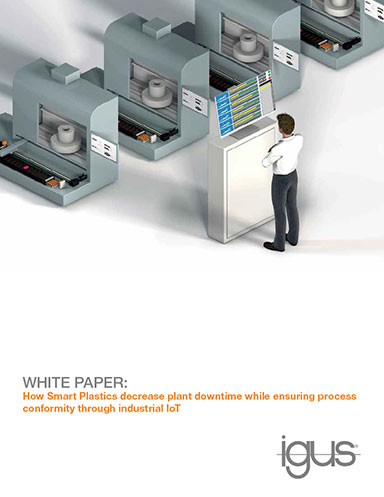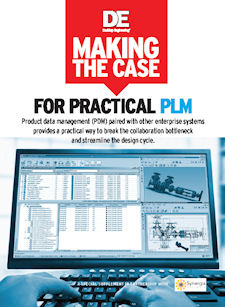Get Practical with PLM
Latest News
September 1, 2014
 What company isn’t under the gun to get products to market faster than the competition while simultaneously reducing waste and cost? With companies struggling under the weight of manual processes and of out-of-control product development-related data, it’s time to get real about finding a solution. With a practical approach to PLM, you can connect everyone in the organization to the right data while facilitating better decision-making that results in great products.
What company isn’t under the gun to get products to market faster than the competition while simultaneously reducing waste and cost? With companies struggling under the weight of manual processes and of out-of-control product development-related data, it’s time to get real about finding a solution. With a practical approach to PLM, you can connect everyone in the organization to the right data while facilitating better decision-making that results in great products.
Organizations have attacked the problem with a variety of technologies, from CAD-centric data management software to enterprise product lifecycle management (PLM) platforms, with varying degrees of success. The challenge is to manage an increasing amount of manufacturing data and to automate business processes without getting bogged down in complex PLM enterprise deployments that consume limited resources, break strapped budgets and take months, or even years to get going.
Rather than trying to “boil the ocean” and map a monolithic platform to a set of complex business processes, organizations need to zero in on the most common product data management (PDM) challenges. They should then go after them with a practical PLM approach that delivers efficiencies right out of the gate, while easily scaling to meet evolving needs.
Here are the most common product data management challenges and how to solve them with a practical approach to PLM that integrates PDM with existing enterprise business processes.
1. Finding Files
By some accounts, engineers spend as much as 40% of their time searching for key files. Most companies are hamstrung by manual processes and far-flung development efforts that lock up critical product data and CAD files in siloed systems that aren’t easily accessible by dispersed design teams, manufacturing or customer service.
Without a central repository and an advanced search capability to quickly find files, team members can’t locate the data they need to make optimal decisions about product direction, and when and if they do, there’s no guarantee they are working with a current version. The inability to quickly find information wastes valuable time that could be better spent doing real engineering work, while it also introduces errors into the design process.
Solution: A product data management platform provides a central repository for all multi-CAD design data, which can be accessed by team members based on their role and according to specified security permissions. There is no need for colleagues to dig up and email required files. Instead, there are structured metadata searches as well as full-text search capabilities that allow for a quick review of the contents of documents. Attribute or property data can provide another layer of detail for examining CAD or non-CAD documents such as Microsoft Office files, transcending what’s possible with basic Windows file management. The ability to save commonly used search criteria can also ensure frequently used content is readily accessible.
2. Revision Control Errors
Conflicting document versions present many challenges, from duplication of effort to poor quality control. According to a 2012 Tech-Clarity survey, approximately 30% of organizations are hindered by inadequate revision control practices.
Manual revision control processes are error-prone and potentially costly, from both a financial and customer satisfaction perspective. Moreover, without an audit trail, companies have no record of who modified what documents, when, which opens the door to legal exposure from a compliance or litigation standpoint. It also makes it difficult to analyze workflow, identify bottlenecks, and improve overall design processes.
Solution: Along with secure and controlled access to a centralized repository of documents, a PDM system automates revision control and maintains an audit trail of changes to any one file, aiding in the traceability so critical for regulatory compliance and certification. Files with parent/child relationships are able to maintain links to current versions, and both major and minor versions and revisions are tracked to eliminate errors and ensure that all players in the design process are working from the same information, even if they are in globally dispersed locations.
3. Change Order Chaos
Engineering change orders (ECOs) are one of the biggest bottlenecks to design productivity and can cost companies plenty, especially if mistakes are made. In many organizations, ECOs are handled manually using spreadsheets, which makes them difficult to orchestrate into a consistent process. Manual handoffs provide no visibility into ECOs and no automated way to alert other stakeholders and departments involved in the workflow as to their status and final approval.
Solution: Leverage a product data management system’s electronic workflow capabilities to automate ECOs and orchestrate a simple or complex routing and approval process. Workflow status updates can be sent via email, and time-based alerts can be set to identify bottlenecks and get projects completed faster. The ability to view the status of an ECO also ensures that any remaining steps are identified and duly completed, leaving no margin for error or overlooked missteps.
4. Collaboration Complications
It’s the rare company today that doesn’t have a need to collaborate beyond its four walls. Regular communication with globally dispersed departments, suppliers, partners and even customers is part and parcel of the modern-day development process, and remains a headache for most engineering organizations.
Without a “single version of the truth,” organized and accurate collaboration is impossible. The rampant use of email only complicates matters, proliferating uncontrolled versions and resulting in product data management chaos. Moreover, sending large CAD files and assembly drawings across multiple sites through email or FTP is painfully slow because the files aren’t replicated locally at each team’s site.
Solution: With a centrally managed and controlled document repository, collaboration is transparent. Project data can be replicated across sites so everyone is working from the most current version without any degradation in performance. The ability to manage and view native, multi-CAD files can simplify design reviews, allowing non-engineering users to view, markup, and compare designs without having to purchase expensive CAD seats or deal with cumbersome and error-prone file conversions.
By integrating a core product data management platform, such as Synergis Adept, with existing enterprise systems, organizations can make collaborative product design the stuff of reality, not PLM fiction.
Download “Making the Case for Practical PLM” at deskeng.com/de/practicalplm.
By the Numbers
40% Can’t find data they’re trying to find.1
39% Cite frequent design changes as the biggest obstacle in the way of efficient design.2
73% Don’t know the cost of engineering change orders.3
200 The number of people, on average, that use information associated with a design created by an individual engineer.4
33%-50% The total engineering capacity consumed by handling engineering change orders (ECOs).5
6 weeks The time it takes SchuF-Fetterolf to develop a new valve enabled by PDM, compared to competitors who typically spend from six to 12 months on valve development.6
42% The amount of duplicated data, according to company estimates.7
36% Organizations suffering severe consequences related to regulatory compliance as a result of failures in document-related business processes.8
3X The likely increase in being “very effective” at managing design projects with effective document management.9
$400,000 The average annual cost of a manual transmittal process for Taggart Global that was saved by automating data management and document management processes.10
1 Tech-Clarity Perspective: “Best Practices for Managing Design Data,” 2012, Jim Brown. Available online at http://www.plm.automation.siemens.com/en_us/Images/Tech-Clarity_Perspective_Design_Data_Best_Practice_tcm1023-184552.pdf
2 Aberdeen Group; “Top CAD Tips For Designing Today’s Products: What Are The Right Tools For The Job?”, March 2012
5 Terwiesch & Loch, 1999. http://cdn.intechopen.com/pdfs/432.pdf
6 Tech-Clarity Insight: “Managing Engineering Data: The Role of Product Data Management in Improving Engineering Efficiency,” 2010, Jim Brown
7 Symantec State of Information: Global Results, 2012. Available online at http://www.symantec.com/content/en/us/about/media/pdfs/2012-state-of-information-global.en-us.pdf
8 IDC white paper, “It’s Worse Than You Think: Poor Document Processes Lead to Significant Business Risk,” 2012. Available online at http://mds.ricoh.com/files/knowledge_center/IDC_Risk_WP_Ricoh_Eng.pdf
9 Tech-Clarity Perspective: “Best Practices for Managing Design Data,” 2012, Jim Brown. Available online at http://www.plm.automation.siemens.com/en_us/Images/Tech-Clarity_Perspective_Design_Data_Best_Practice_tcm1023-184552.pdf
10 Synergis case study
Subscribe to our FREE magazine, FREE email newsletters or both!
Latest News
About the Author
DE’s editors contribute news and new product announcements to Digital Engineering.
Press releases may be sent to them via [email protected].






